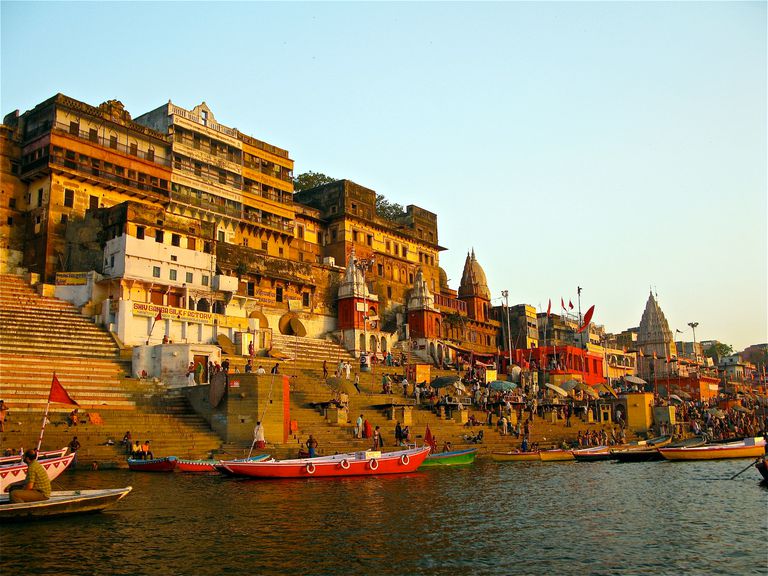Varanasi, the parliamentary constituency of Prime Minister Narendra Modi, is all set to become the first city with zero discharge of polluted water into river Ganga. By July this year, the sewage treatment capacity of Varanasi will exceed 400 million litres per day (MLD), checking the flow of sewer water in the river completely. Officials said this will be a big step towards making Ganga clean by 2020, under the Namami Gange project initiated by the Modi government. Modi government had launched the Namami Gange programme in June 2014 with a budget outlay of Rs. 20,000 crore to accomplish the twin objectives of effective abatement of pollution, conservation and rejuvenation of the Ganges. The National Commission for Clean Ganga, the implementation wing of National Ganga Council was set up in October 2016 under the River Ganga (Rejuvenation, Protection and Management) Authorities order 2016.
The Namami Gange has earmarked Rs. 13 crores for cleaning 94 ghats in four cities of Uttar Pradesh – Kanpur, Prayagraj, Bithoor and Mathura-Vrindavan. In Varanasi, the government has hired a private concessionaire for cleaning Varanasi’s 84 ghats for three years at the cost of Rs 5 crore per year. Under the Namami Gange programme, for Varanasi, the upcoming Sewage Treatment Plant (STP) at Rammana with a capacity of 50 MLD will treat the polluted water coming from Assi river, which is a major source of pollution in the Ganga. The current sewage generation in Varanasi is estimated at 300 MLD, which is expected to increase to 400 MLD in the year 2035. At present, the three operational STPs in the city have 102 MLD treatment capacity. However, with the upcoming 3 STPs, the total sewage treatment capacity will go up to 412 MLD, which is adequate to meet the demand until 2035.Rs 20,000-crore Namami Gange project has been accelerated. Around 70-80% work is expected to be completed by March 2019 while the remaining would be over by December 2019. 75% of the funds earmarked for the project will be spent by March 2019. The Sisamau drain, which has brought infamy to Kanpur for causing pollution in Kanpur was tapped in October. Besides, solid waste lying on the banks of the river would be recycled to run biofuels buses.
NMCG has taken up 11 projects under the ‘Namami Gange’ programme to conserve the Yamuna in Delhi. Most projects are part of improved sewerage infrastructure that are at various stages of implementation. Under the Yamuna Action Plan III, new sewer lines will be built, and sewage treatment plants modernized across Delhi’s three drainage zones — Kondli, Rithala and Okhla. There was also an agreement between the National Mission for Clean Ganga (NMCG), the UP Jal Nigam and the private consortium at the other end is part of the ‘One City-One Operator’ concept. The deal is structured under a hybrid annuity Public-Private-Partnership (PPP) model. Under the plan, three new STPs will be built at Unnao, Shuklaganj and Pankha and the existing sewage treatment network will be overhauled to a capacity of treating 45.7 crore litres of sewage. The consortium will bear responsibility for operation and maintenance of the entire sewage treatment infrastructure for a period of 15 years. The cost of the entire contract is Rs 908 Crores, with Rs 370.40 Crores out of that being spent on building 401 km of new sewage lines in Kanpur, expected to be complete in 2020.
In case of Varanasi Works on two projects 50 MLD in Varanasi are nearing completion under the HAM and other projects that are sanctioned include Naini, Jhusi, Phaphamau, Unnao, Shuklaganj, Mathura, Kanpur, Mirzapur, Gazipur and Farrukhabad in Uttar Pradesh; Digha, Kankarbagh and Bhagalpur in Bihar; and in Howrah, Bally, Kamarhati and Baranagar in West Bengal, apart from Tolly’s Nalla in Kolkata.
According to a report in Sunday Guardian Live Vinod Manjhi, a boatman at the Assi Ghat in Varanasi said: “Earlier, tourists would avoid visiting the Ganga ghats as these were in a bad shape. The filth around the ghats was a big deterrent for foreigners in particular. But the river banks are very well maintained now and there has been a gradual rise in the number of tourists.”
The efforts are finally showing here in Varanasi. Locals said that the sustained cleaning of the river ghats in Varanasi, coupled with infrastructure support to check the flow of polluted water, has made Ganga cleaner than before. They said that the footfall of tourists, particularly foreigners, has gone up significantly at the ghats of Varanasi in the last couple of years since the launch of the Ganga cleaning projects.
